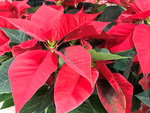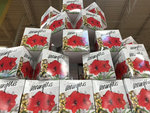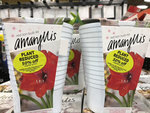


Three plants play starring roles in the holiday season: poinsettias, amaryllis, and the multiple species of evergreens that become Christmas trees.
There are, of course, other plants that play supporting roles, like Christmas cacti, holly, and mistletoe. But it’s the big three that provide the most pleasure, and the most angst when they fail to perform.
So let’s gossip about the stars:
Poinsettias are natives of Mexico that are grown for their big red bracts, which most of us think of as flowers. Now they’re also available in white, pink, and with spotted bracts. In the United States, we buy 35 million of them yearly over about six weeks.
Soon after the holidays – and sometimes before – an awful lot of people have poinsettias with dead and dying leaves. That’s because these divas want plenty of light – more hours of it than our winter days provide. Electric light helps but often isn’t enough. They are also picky about water; they want a steady supply, but not much of it. With both light and water, consistently hitting their sweet spot is always challenging.
The truth is that most of them don’t survive long. But some people, through luck rather than skill, have a perfect spot for pleasing a poinsettia and keep them around much longer.
I read online this morning that a man claims to have kept a poinsettia alive for 75 years. That made me wonder how old he was when he started. Did someone give him a poinsettia for Christmas when he was five? Or is he, as George W. Bush might say, overexaggerating?
Auntie Google’s advice about what to do with a poinsettia after the holidays is this: “Toss the poinsettia when you grow tired of it, or it becomes unattractive.”
If you really want to keep it, there is a wealth of advice on Google about how to do so. Good luck, but keep in mind that few stars age gracefully.
Poinsettias offer the instant beauty of a mature plant, but amaryllis bulbs provide the joy of watching something sprout, grow taller day by day, and bloom gloriously about five weeks after it’s planted.
Amaryllis bulbs are so eager to grow that if they see even a sliver of light, they burst out of their boxes before they’re even sold. Each bulb contains all the nutrients it needs to bloom. For this reason, some sellers now dip the bulb in wax and suggest just placing it in a container that will hold it upright. That seems like plant abuse to me.
But it is also possible to be too kind to an amaryllis; they do better in a narrow, crowded pot than in a spacious one. And they, like poinsettias, are intolerant of wet feet from too much water.
Amaryllises have a big strong stem that doesn’t need staking, and robust, strapping leaves. They traditionally grow about 18 inches tall. They are most commonly red but, for the last few years, they’ve been showing up in a growing list of other colors. They are on sale now at most grocery and big-box stores; you can often find them for less than $10.
Like poinsettias, keeping an amaryllis around for multiple years takes both skill and luck. If you want to try, ask Santa for a greenhouse.
It’s very easy to get an amaryllis bulb to grow and bloom; it’s just harder to keep them around for a second annual performance.
I have friends who call these evergreens “solstice trees” or “Hannukah bushes.” Kids from many non-Christian traditions often pressure their parents into installing one in the living room this time of year – a trend contrary to the myth that there is a need to “bring back Christmas.” Christmas is such a dominant American economic and cultural tradition it leaks under every doorway.
The National Christmas Tree Association says there are 350,000 acres of these trees grown in the U. S. If they were left to grow, that would be an impressive forest. But if they were left to grow, more people would buy artificial trees, and miss out on the wonderful smell of a fresh evergreen in the house.
These trees need water, and lots of it, for as long as they are in your house. Letting them dry out will put you on the naughty list.
If you buy a potted living tree, do your research: How long can it stand to be indoors? When is the best time to plant it out? And most important: How big will it grow? Fir, hemlock and most varieties of pine will outgrow urban yards in just a few years. Better to look for something that will stay smaller, like Dwarf Alberta Spruce.
And for all of these plants, better to shop soon, as the curtain has risen on this year’s holiday rush.
Jill Severn writes from her home in Olympia, where she grows vegetables, flowers, and a small flock of chickens. She loves conversation among gardeners. Start one by emailing her at jill@theJOLTnews.com
1 comment on this item Please log in to comment by clicking here
sunshine39
Good info, but don't forget paperwhites, fragrant and easy
Saturday, November 26, 2022 Report this